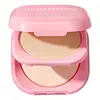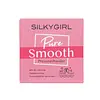What's inside
What's inside
 Key Ingredients
Key Ingredients

 Benefits
Benefits

 Concerns
Concerns

 Ingredients Side-by-side
Ingredients Side-by-side

Talc
AbrasiveMica
Cosmetic ColorantCI 77891
Cosmetic ColorantSilica
AbrasiveTriethylhexanoin
MaskingNylon-12
CI 77492
Cosmetic ColorantSqualane
EmollientTriethoxycaprylylsilane
Magnesium Myristate
Caprylyl Glycol
EmollientEthylhexylglycerin
Skin ConditioningCI 77491
Cosmetic ColorantCI 77499
Cosmetic ColorantLauroyl Lysine
Skin ConditioningAluminum Hydroxide
EmollientDimethicone
EmollientMethicone
EmollientTocopherol
AntioxidantTalc
AbrasiveTitanium Dioxide
Cosmetic ColorantEthylhexyl Methoxycinnamate
UV AbsorberMagnesium Stearate
Cosmetic ColorantAluminum Starch Octenylsuccinate
AbsorbentZinc Stearate
Cosmetic ColorantBenzophenone-3
UV AbsorberPhenyl Trimethicone
Skin ConditioningGluconolactone
Skin ConditioningDisiloxane
Skin ConditioningSodium Benzoate
MaskingCalcium Gluconate
HumectantTocopheryl Acetate
AntioxidantCI 77491
Cosmetic ColorantCI 77492
Cosmetic ColorantCI 77499
Cosmetic ColorantCI 77007
Cosmetic ColorantIngredients Explained
These ingredients are found in both products.
Ingredients higher up in an ingredient list are typically present in a larger amount.
Ci 77491 is also hydrated iron III oxide. It's sole purpose is to give a red/pink hue to products.
Iron III oxides are classified as inorganic chemicals for coloring.
Synthetically created Ci 77491 is considered safer than those naturally found. This is because the synthetically created version may contain less impurities. Iron oxides are generally non-toxic and non-allergenic.
Learn more about CI 77491Ci 77492 is also hydrated iron III oxide. It's sole purpose is to give a yellow hue to products.
Iron III oxides are classified as inorganic chemicals for coloring.
Synthetically created Ci 77492 is considered safer than those naturally found. This is because the synthetically created version may contain less impurities. Iron oxides are generally non-toxic and non-allergenic.
Learn more about CI 77492Ci 77499 is also hydrated iron III oxide. It is created from mixing red and black iron oxides. This helps give shades of darkness to a product.
Iron III oxides are classified as inorganic chemicals for coloring.
Talc is a clay mineral. It helps absorb moisture and improve the texture of products. Like other types of clay, Talc can have a slight exfoliating effect on skin. Talc can be added to increase the volume of products.
Some Baby powders are made by combining talc with corn starch. The word "talc" comes from Latin and originates from Arabic. Talc is a mineral commonly found throughout the world.
If you have any concerns about using talc, we recommend checking out the FDA's official page.
Learn more about Talc